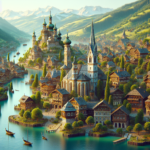
#ez-toc-container {
background: #f9f9f9;
border: 1px solid #aaa;
border-radius: 4px;
-webkit-box-shadow: 0 1px 1px rgba(0, 0, 0, .05);
box-shadow: 0 1px 1px rgba(0, 0, 0, .05);
display: table;
margin-bottom: 1em;
padding: 10px 20px 10px 10px;
position: relative;
width: auto;
}
.ez-toc-container-direction {
direction: ltr;
}
.ez-toc-list-level-1 a{
font-weight:bold;
}
Table of Contents
1. Introduction to Cultural Marvels
Cultural tourism has emerged as a significant force driving the global travel industry. As travelers seek deeper connections and enriching experiences, cultural sites worldwide have gained prominence. This exploration of cultural marvels not only opens doors to diverse traditions and histories but also plays a crucial role in fostering personal growth and global understanding. In this introduction, we delve into the significance of cultural tourism, the growing interest in exploring cultural sites, and the invaluable benefits these experiences offer.
The Significance of Cultural Tourism
Cultural tourism encompasses travel to destinations where cultural forms, practices, expressions, and artifacts are celebrated. It allows visitors to immerse themselves in the way of life of different communities, offering not just leisure but a profound understanding of diverse cultures. The significance of cultural tourism can be outlined as follows:
- Preservation of Heritage: Cultural tourism plays a vital role in preserving historical and cultural heritage sites. By promoting awareness and appreciation, it ensures that these treasures are protected for future generations.
- Economic Impact: It contributes significantly to local economies by creating jobs and supporting industries such as hospitality, transportation, and crafts.
- Promotion of Cross-Cultural Exchange: It fosters dialogue and understanding among different cultures, helping to bridge gaps and address misconceptions.
These factors underscore the importance of cultural tourism, not just as a means of leisure, but as a powerful tool for cultural retention and economic growth.
The Growing Interest in Exploring Cultural Sites Worldwide
In recent years, there has been a noteworthy increase in the number of travelers who prioritize cultural sites on their itineraries. Several reasons account for this growing interest:
- Heightened Awareness: With globalization and digital connectivity, people are more aware of global cultures and are keen on experiencing them firsthand.
- Authentic Travel Experiences: Travelers are increasingly seeking authentic experiences that go beyond conventional sightseeing. Cultural sites offer unique insights into a region’s history and way of life.
- Events and Festivals: Cultural events and festivals attract travelers, offering them a chance to partake in local traditions and customs.
Such motivations highlight the shift in travel preferences, reflecting an eagerness to learn and engage with cultures different from one’s own.
The Importance of Cultural Experiences in Personal Growth and Global Understanding
Embarking on cultural tourism is not just an exploration of new landscapes, but a journey of personal and intellectual growth. Here’s why cultural experiences are crucial:
- Expanding Worldviews: Encountering different cultures broadens one’s perspective, challenging preconceived notions and fostering a more inclusive worldview.
- Building Empathy and Tolerance: Engaging with diverse cultural practices cultivates empathy and tolerance, essential qualities for harmonious global coexistence.
- Enhancing Communication Skills: Cultural immersion often necessitates overcoming language barriers, thereby enhancing communication skills and cultural literacy.
- Inspirational Learning: Learning about the achievements, struggles, and innovations of various cultures can inspire individuals to reflect on and appreciate their own culture’s unique contributions.
By understanding and appreciating cultural differences, travelers contribute to a more interconnected and harmonious global community.
As the world continues to embrace cultural tourism, the benefits extend beyond the traveler to impact societies at large. Cultural tourism not only holds the promise of adventure and exploration but also serves as a bridge for cultural understanding and a catalyst for personal growth. As more individuals embark on explorations of cultural marvels, they pave the way for a more enriched and integrated global experience, ensuring that the treasures of the past and the narratives of diverse peoples continue to thrive.

2. Identifying the Top Cultural Travel Destinations
Cultural travel offers an unparalleled opportunity to delve into the soul of a location. By exploring the world through its cultural marvels, travelers not only satisfy their wanderlust but also gain insights into the rich heritage and traditions that define a place. In choosing the top cultural travel destinations, several factors make a destination a cultural marvel.
Factors That Make a Travel Destination a Cultural Marvel
Not all destinations can boast the title of a cultural marvel. Such a distinction requires a unique blend of characteristics that set it apart. When evaluating potential cultural hotspots, several critical factors come into play:
- Historical Significance: A place steeped in history offers a nuanced understanding of past civilizations, landmark events, and the evolution of humanity itself. Destinations with an extensive historical background often preserve relics, documents, and traditions that narrate stories from centuries past.
- Architectural Brilliance: Distinctive architecture and design, whether ancient or modern, speak volumes about a region’s cultural and aesthetic values. From ancient ruins to stunning contemporary structures, architecture reflects the level of craftsmanship and artistic expression over time.
- Cultural Festivals: Vibrant cultural festivals showcase the living traditions, music, dance, and culinary delights of a nation. They offer travelers a sensory-rich experience that embodies the cultural ethos and spirit of a community.
- Artistic Heritage: The strength of a destination’s art scene—be it in painting, sculpture, music, or literature—contributes significantly to its cultural standing. Museums, galleries, and live performances reveal the creative output that has marked civilizations.
- Authentic Traditions: The enduring customs and practices of a region, including traditional clothing, rituals, and everyday practices, offer a window into the societal norms and values of its people.
Introduction to Criteria for Selecting Top Places
When selecting the world’s top cultural travel destinations, a few key criteria help discern the truly exceptional from the merely interesting:
- Historical Significance: Evaluating the importance of historical landmarks and their narratives in shaping modern civilization. Sites that have borne witness to significant events or epochs are prioritized.
- Architectural Brilliance: The uniqueness, age, and preservation efforts of architectural structures—from ancient ruins to avant-garde modern edifices—are considered.
- Cultural Festivals: Frequency, international reputation, and the experience offered by cultural festivals help gauge a place’s liveliness and commitment to tradition.
- Rich Artistic Heritage: The presence of world-renowned art, music, and literature, along with institutions that house and celebrate such works, are vital.
- Authenticity of Traditions: A region’s adherence to and celebration of traditional practices and artisanship play a significant role in its cultural appeal.
Highlighting Renowned Cultural Marvels Across Continents
Let’s take a journey across continents, exploring renowned cultural marvels that have captivated the imaginations of travelers for generations:
Europe
- Florence, Italy: Known as the cradle of the Renaissance, Florence is a treasure trove of art and history. The city houses masterpieces by Michelangelo, Leonardo da Vinci, and Botticelli, with iconic sites like the Uffizi Gallery and the Florence Cathedral.
- Paris, France: From the awe-inspiring architecture of the Eiffel Tower and Gothic marvel of Notre-Dame to the artistic prowess displayed within the Louvre, Paris stands as a symbol of romance and culture.
- Athens, Greece: A city that blends ancient history with a vibrant contemporary culture. The Acropolis and the Parthenon are testimonies to Athens’ pivotal role in the development of Western civilization.
Asia
- Kyoto, Japan: Famous for its classical Buddhist temples, lush gardens, imperial palaces, and traditional wooden houses, Kyoto offers an escape to Japan’s rich historical and spiritual past.
- Varanasi, India: One of the world’s oldest continuously inhabited cities, Varanasi is a cultural and spiritual hub for Hindus, featuring sacred rituals along the Ganges River.
- Beijing, China: Home to the Great Wall and the Forbidden City, Beijing’s historical gravitas is unmatched, reflecting centuries of Chinese imperial history.
Africa
- Marrakech, Morocco: This city enchants with its maze-like medina, vibrant souks, magnificent palaces, and the annual Marrakech Popular Arts Festival showcasing local music, dance, and traditions.
- Cape Town, South Africa: Nestled between mountain and sea, Cape Town boasts a rich colonial history intertwined with vibrant art, music, and diverse cultural influences.
Americas
- Machu Picchu, Peru: An archaeological marvel, the ruins of Machu Picchu offer insights into the Incan Empire’s sophistication and ingenuity, beautifully perched in the Peruvian Andes.
- Mexico City, Mexico: With its ancient Aztec ruins, Baroque cathedrals, and the colorful vibrancy of neighborhoods like Coyoacán, it is a cultural powerhouse in Latin America.
Oceania
- Sydney, Australia: Beyond the Opera House and Harbour Bridge, Sydney’s rich aboriginal history and diverse culinary scene make it an eclectic cultural destination.
- Auckland, New Zealand: A city that seamlessly blends its Maori heritage with a thriving modern cultural landscape, arts festivals, and stunning natural beauty.
The world is dotted with cultural marvels waiting to inspire, educate, and enchant. These remarkable destinations are not merely places on a map but thriving testaments to human creativity and resilience, inviting travelers to explore and embrace the world’s cultural richness.



